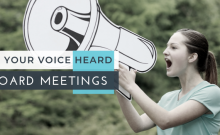Part one of a three-part series
One of the most important benefits you provide members is often the hardest to deliver: advocacy.
As the umbrella group that represents the interests of your industry, members count on you to stay on top of issues and build relationships with both state and federal governments to make sure their voices are heard.
But, getting your arms around this enormous task can be overwhelming. Government relations is like the Wild West. There are lots of prospectors looking to make a name for themselves, and very few rules.
Is your association doing what it should to present your industry’s viewpoints to government decision makers?
The time is now
If there’s room for improvement in your advocacy efforts, now is the time to take action. There are so many business regulations and issues under inspection in our changing political climate. It’s important to help legislators and administrators understand the impact their decisions may have on your industry.
Your members are counting on you.
Let’s get started
There are three strategies that associations can employ to develop a successful government relations program:
- Create an outreach program
- Build a coalition of like-minded organizations
- Retain and manage a lobbyist
In the first of a three-part series, let’s discuss how to create an outreach program that taps the resources you have in place now.
Creating an outreach program
The most immediate way to establish an advocacy program is to manage it internally, either with staff or a member volunteer at the helm. Your goal is to establish relationships with key legislators before you need them.
The first step is to identify and prioritize what issues affect your industry and what positions benefit your membership. It’s important to have a strong set of talking points backed by research so everyone is communicating the same messages.
Then, call your legislators’ district offices (both federal and state) and request a meeting for coffee, lunch or a face-to-face in his/her office. It’s your chance to discuss general issues affecting your industry. Tell him or her how these issues affect your members’ businesses. Share both positive and negative feedback. Once you have established a relationship, he or she will be more likely to take your call or pay attention to your email when an issue boils up.
You can also invite your legislator to visit your office and meet your employees. Schedules are tight for most legislators, but they appreciate the opportunity to meet their constituents in a group setting. They have the opportunity to get to know you, the industry, and the issues you face.
If relevant, invite your legislator to visit a member’s project site. It’s a good one-on-one opportunity to show your representative firsthand the work that your members do. And legislators are always looking for photo opportunities for newsletters and social media.
Attend local events held by your legislator. When possible, get a foursome together and attend your legislator’s golf outings. Or visit with him or her at a local reception fundraiser. Let him/her know that you value the work he/she does. This is a political, rather than a governmental function, so keep specific issue discussions to a minimum and simply let him or her know you appreciate their interest in your industry or profession.
Continue to share feedback on a regular basis to nurture an ongoing relationship with the legislator and his/her staff. You want them to know your organization is monitoring what’s going on and can serve as a resource for the legislator and his/her colleagues when issues arise. One important caveat, make sure you are aware of the laws governing your association as they relate to state and federal lobbying and political fundraising.
Evaluate your outreach program on a quarterly basis to measure its effectiveness and to plan ahead for the coming months.






